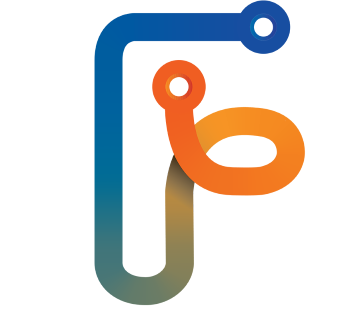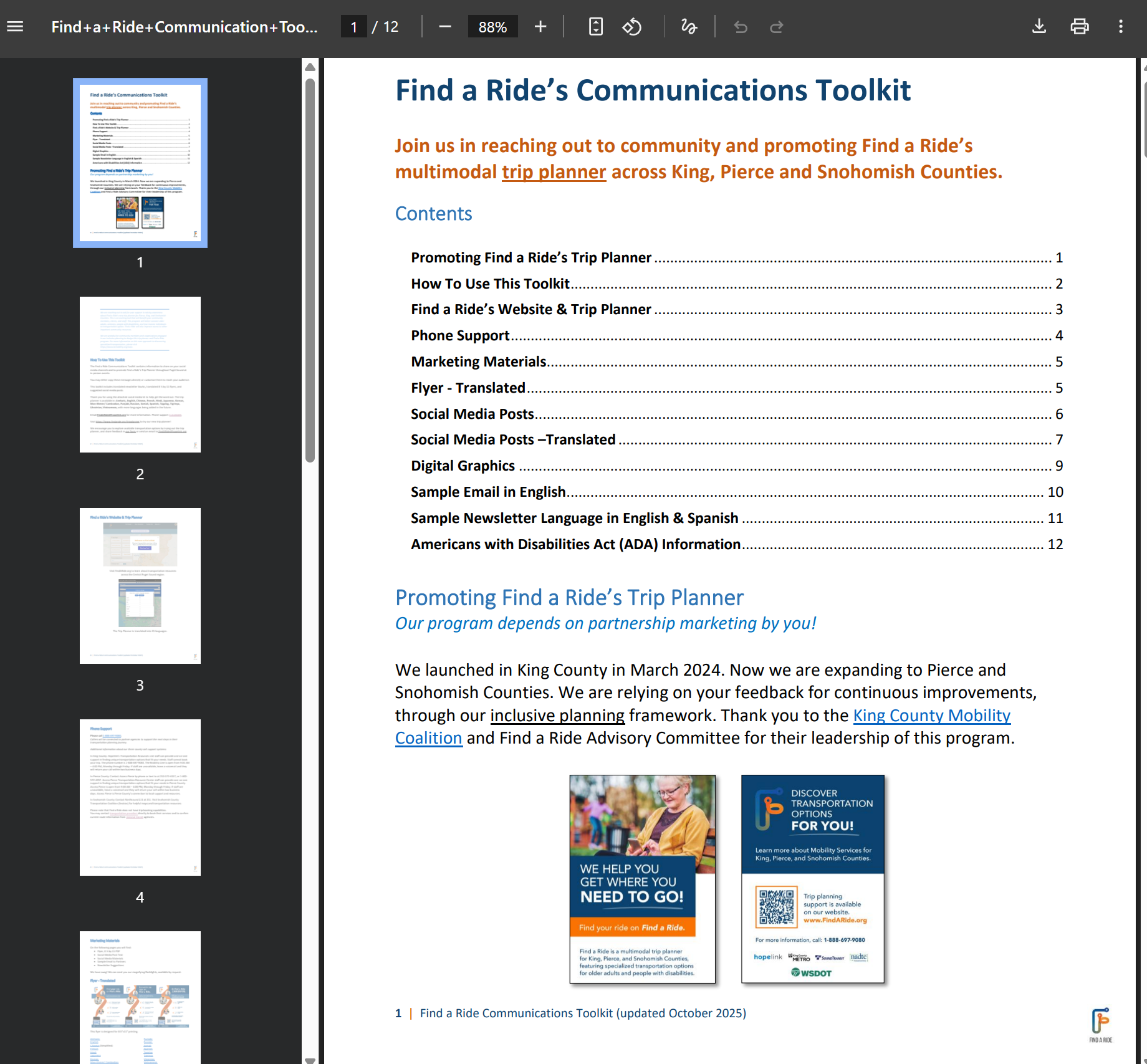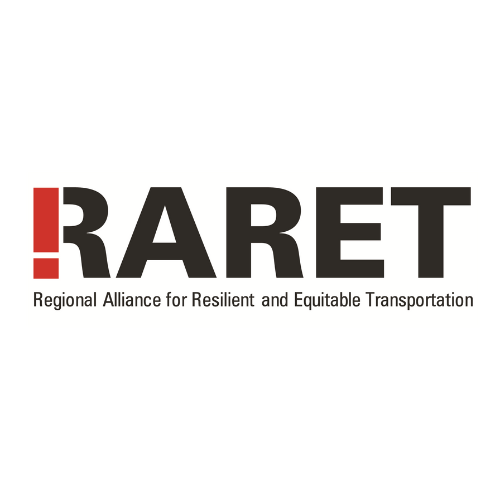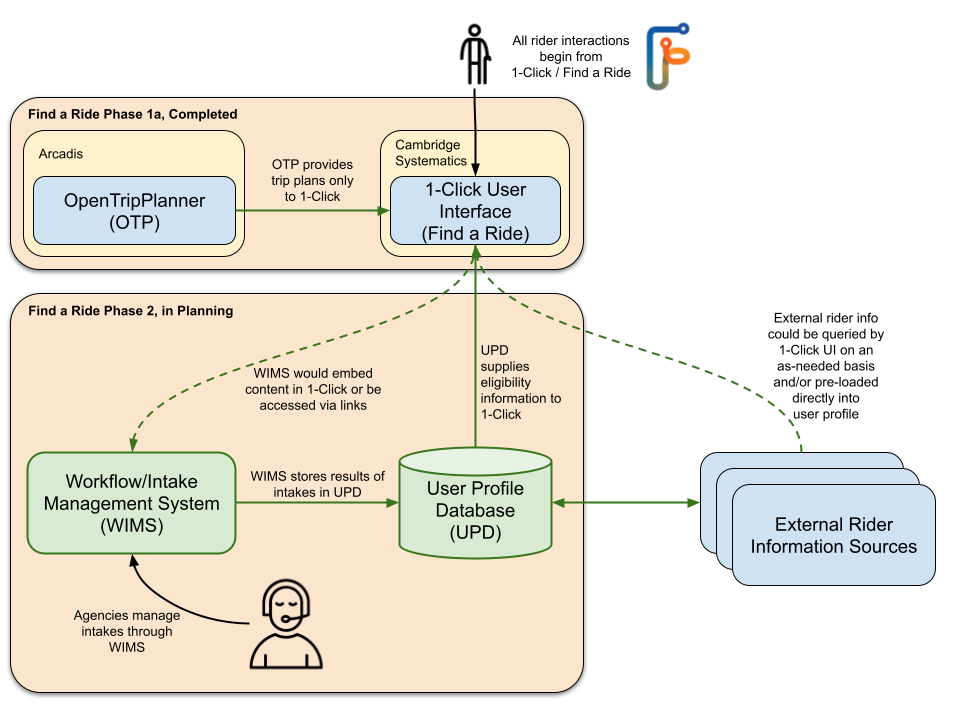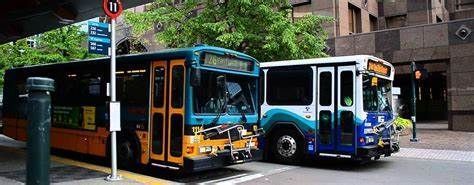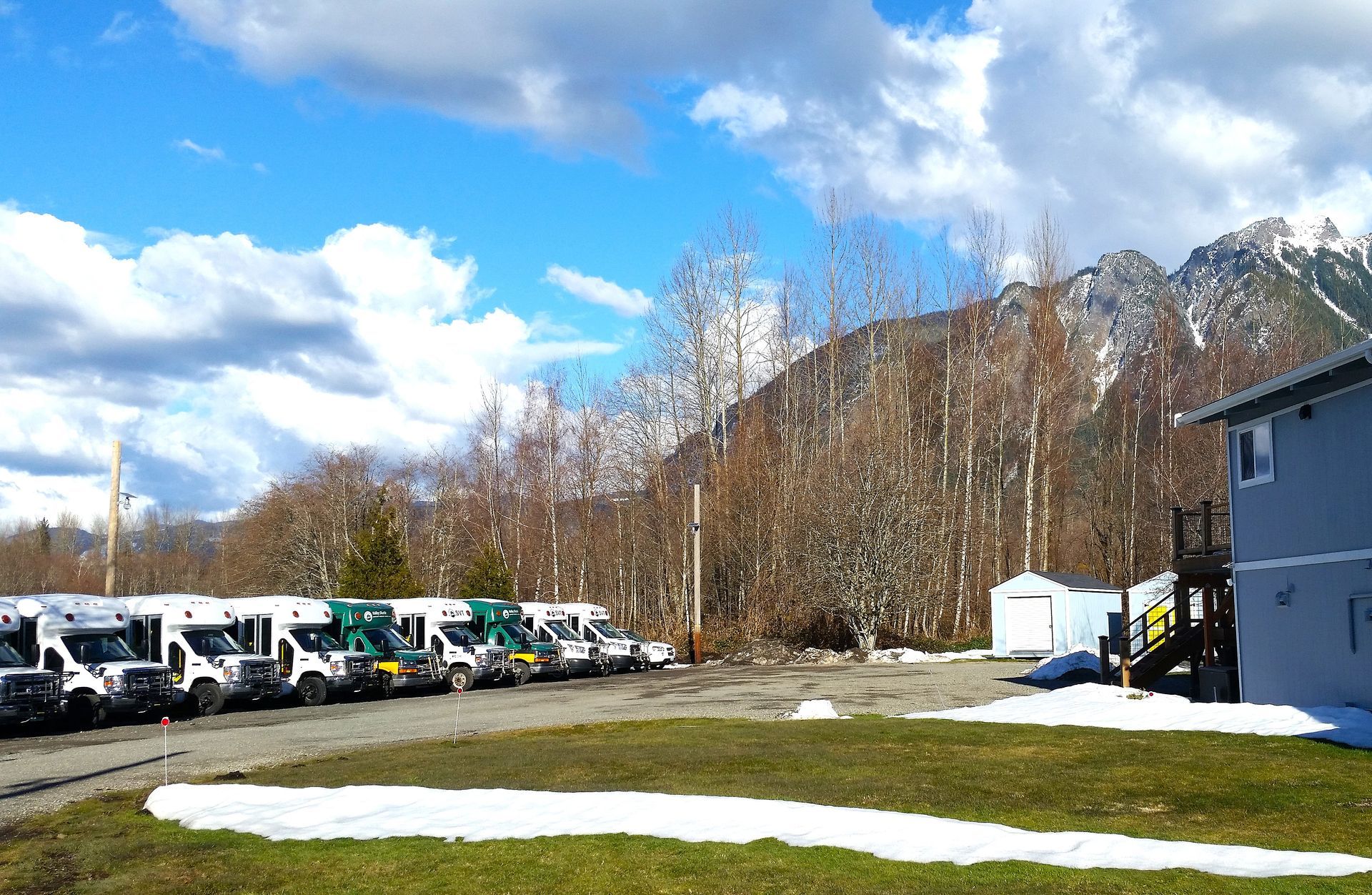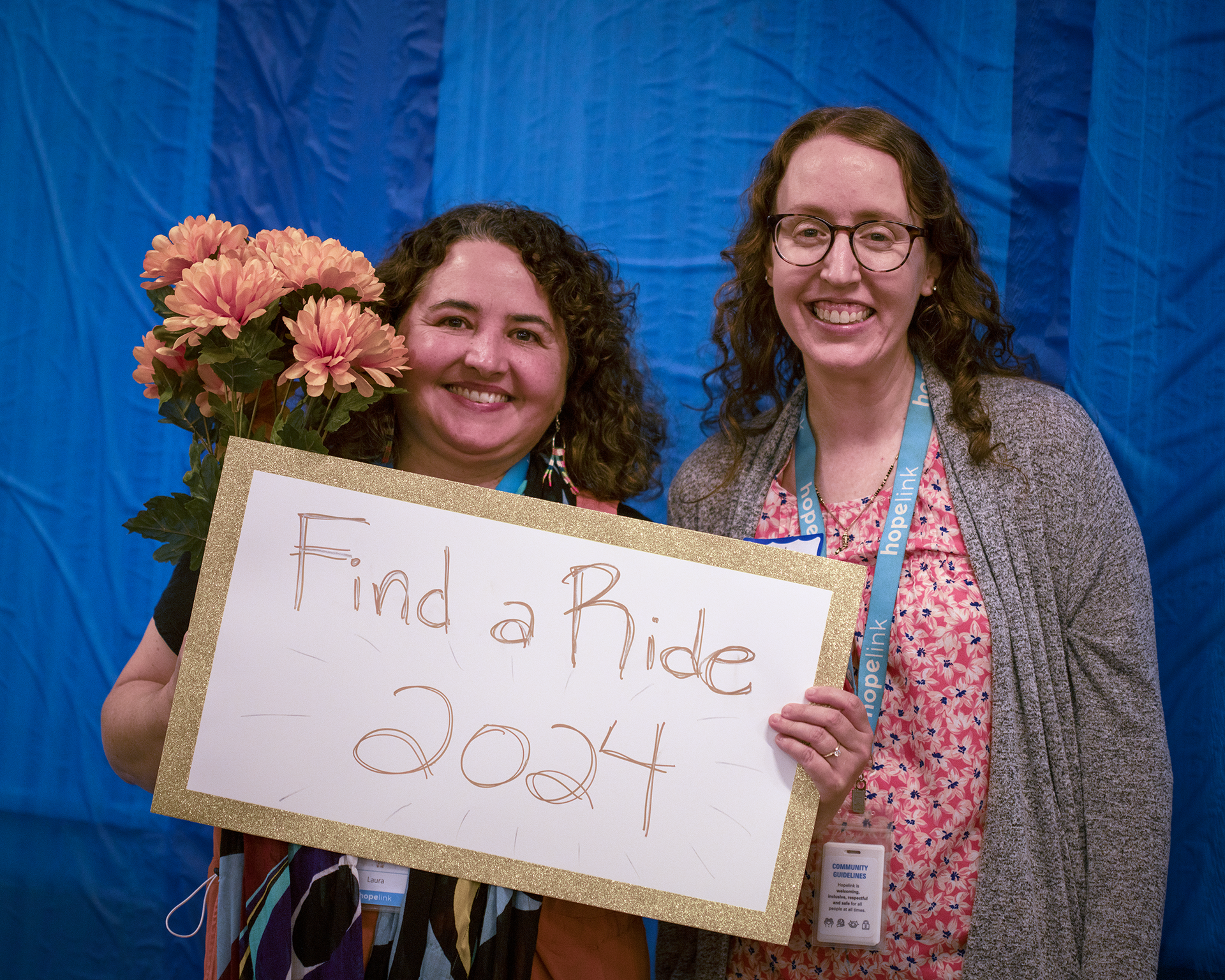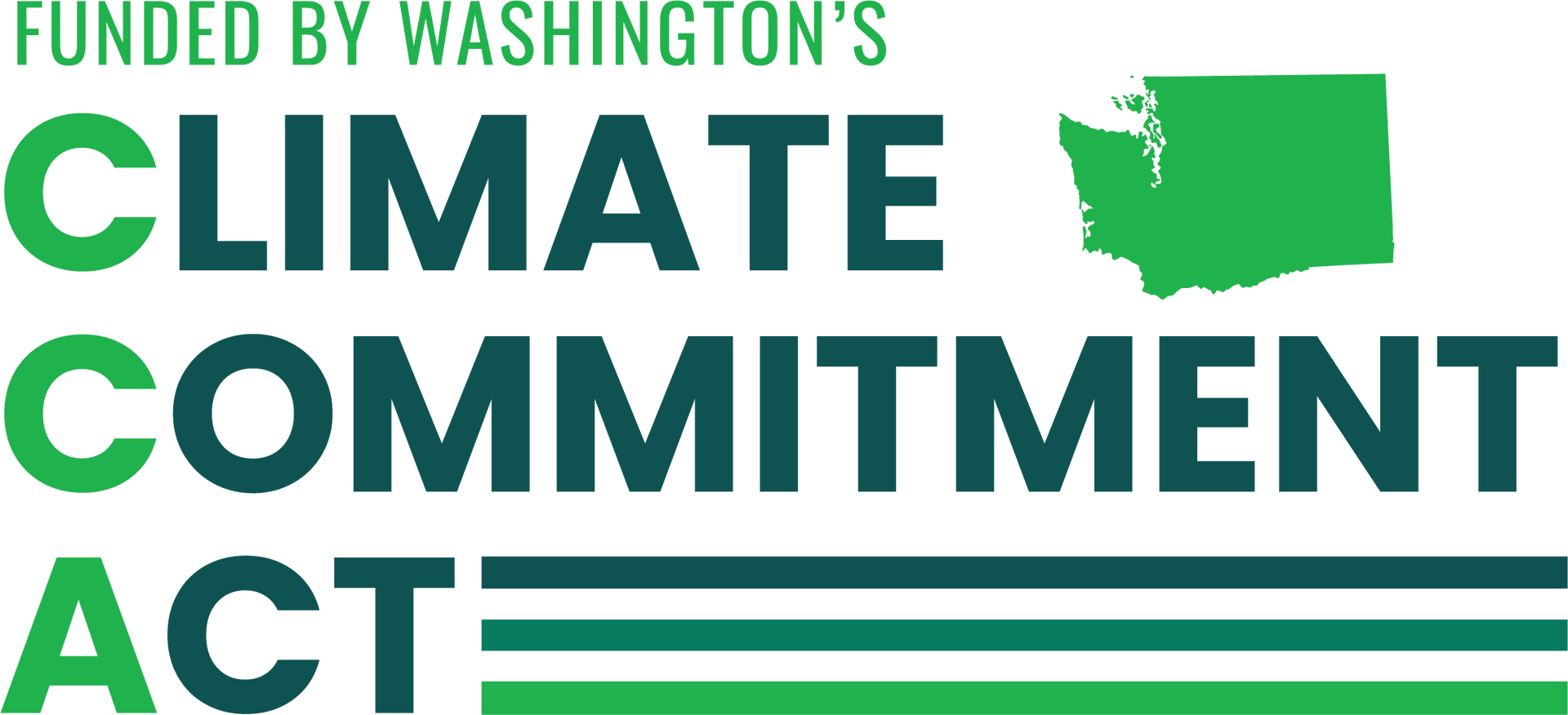Find a Ride Phase 2 Readiness
Next Steps in Advancing Equitable Mobility Through Easy On-Boarding
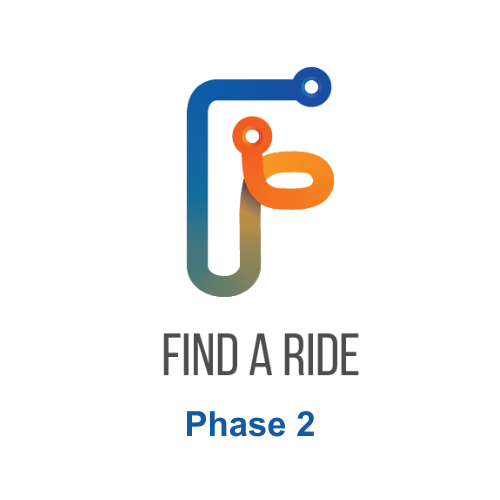
Acknowledgments
Find a Ride is indebted to the work of Kevin Chambers, from Full Path Transit Technology who prepared this report, with input from Hopelink’s Find a Ride Leadership Team. Thank you to Find a Ride's project partners, funders, and community members who lent their support to our Phase 2 Innovative Coordinated Access and Mobility Grant (ICAM) application.
Introduction to One-Call/One-Click
The current transportation system burdens community members to find rides on their own. This becomes especially tricky for anyone who wants to use specialized transportation. At their simplest, one-call or one-click services enable customers to make one phone call or search one website to receive information about all transportation services available in King, Pierce, and Snohomish Counties.
The Problem
► The core challenge Phase 2 seeks to address is that among the many eligibility-based services in the Puget Sound region, each has its own unique set of rules and procedures for rider intake, eligibility determination, and enrollment verification. In most cases, these are manual processes.
This leads to:
- Significant barriers for new riders, where difficulties in accessing first-time services results in limited regional mobility. This often occurs during a period of transition, when specialized services can have a positive impact on a person’s life.
- Labor-intensive processes for agencies, where manual and one-off processes divert the limited resources.
- Lack of regional coordination between agencies makes it hard to invest in tools that work across the entire region because each agency has its own processes.
Proposed Solution
► In its ICAM grant application, Hopelink proposed a system that, at a high level, would:
- Collect new rider intakes electronically through a secure web-based application, including all necessary documentation.
- Support streamlined eligibility determinations with adaptable workflows that cater to both riders and agency staff.
- Securely store eligibility information in a centralized database for use by riders, agency staff, and Find a Ride's trip planner.
► Through this system, Hopelink aims for:
- A 40% decrease in time spent completing paperwork and registering for programs,
- A 20% increase in users enrolled in at least one new service, and
- 80% project satisfaction from Project Partners and Advisory Committee
Current Conditions In the Region
► Broadly speaking, there are no consistent approaches to managing rider intake, determining eligibility, or verifying enrollment in the region.
- As mentioned earlier, the processes of most small, specialized transportation providers rely on manual methods to establish eligibility for new riders.
- Some larger providers, such as King County Metro’s Paratransit service, Access, are developing more digitized and streamlined onboarding processes. However, these improvements are unique to each large provider and cannot be readily replicated by other large agencies, let alone smaller ones.
- The Medicaid brokerage for non-emergency medical transportation in King and Snohomish Counties (operated by Hopelink) maintains an up-to-date database of people eligible for its services, but this data is held as strictly confidential by state and federal regulation and unlikely to be shared as part of a broader coordination effort without a significant legal and technical investment.
- ORCA, the region’s e-fare platform, offers eligibility-based reduced fare programs for youth, seniors, individuals with disabilities, and those with lower incomes. It’s possible to apply for these programs electronically through online portals implemented by ORCA member agencies, but ORCA does not readily support integrations to enable eligibility determinations for other services.
- ADA paratransit services in the region share eligibility information to support reciprocity agreements; however, this is currently a manual process involving phone calls between agency paratransit staff for each rider that requests service outside of their area of residence.
- Outside of these ADA paratransit providers, there are no well-established agreements for sharing rider data between organizations.
► Despite the general lack of coordination in rider onboarding, there are other coordination efforts that are noteworthy:
- The expansion of Sound Transit Light Rail into multiple counties is helping to drive the development of data exchange systems designed to enhance operational coordination between ADA paratransit services. This includes a proposed Regional ADA Paratransit ID (RAPID) for any rider eligible for ADA Paratransit services in the region. Such systems could enable paratransit fleets to coordinate rider journeys under various scenarios, with mechanisms to facilitate reconciliation and reimbursement after the services are provided.
- King County’s licensing department of for-hire transportation, which regulates taxis and TNCs, is developing a centralized dispatch system to manage the County’s limited number of wheelchair-accessible for-hire vehicles.
- These efforts are in their early stages. While the types of coordination and required technology may differ from those in Find a Ride’s Phase 2, both aim to increase access for people with mobility barriers. Furthermore, their success would involve coordination like the prior projects carried out by Hopelink and the King County Mobility Coalition. As such, there may be opportunities to join forces in a way that allows these other projects to benefit from Hopelink’s coalition-building experience.
RFI Responses
► In March, Hopelink issued a request for information (RFI) to gather information from technology solutions providers interested in addressing the challenges described earlier. The RFI expressed particular interest in similar efforts undertaken elsewhere, measures of success for similar projects, and recommendations for approaches to data security.
► The following organizations provided detailed responses:
- Cambridge Systematics, a national transportation consulting firm that is a current vendor for Phase 1 of Find a Ride, provides the “One-Click” open-source tool.
- CaseWorthy, a provider of data management systems for human services providers, currently provides tools for several of Hopelink’s human services programs.
- DemandTrans, a technology development company with experience in both demand-responsive transportation and the healthcare industry.
- Spare Labs, a public transportation technology company focused on tools to plan and operate ADA paratransit, microtransit, and other types of demand response services.
- TransitOps, a company that develops and supports open technology tools for effective and equitable public transit.
- Ready Computing specializes in data integration within the healthcare industry, focusing on providing healthcare workers with the data they need at the point of care.
► Responses fell into two broad categories: those from providers with developed solutions (CaseWorthy, Ready Computing, and Spare Labs) and those from software development firms interested in helping Hopelink develop new tools or integrate existing ones (Cambridge Systematics, DemandTrans, and TransitOps).
Built Solutions
► Given that the work of Find a Ride Phase 2 sits at the intersection of transportation and human services, Hopelink reached out to vendors of technology solutions in both domains. For developed solutions, we received one response from the transportation sector and two from human services.
Spare Labs has recently initiated a project with King County Metro’s Access ADA paratransit program to modernize its eligibility processes and is eager to expand its presence in the region, providing additional tools that support eligibility-based services. While Spare’s current offerings do not appear to include extensive tools for coordinating eligibility management across multiple providers, they do provide a comprehensive set of features and workflows for managing intakes, determinations, and enrollment with a single agency. These capabilities could possibly be extended to work in the multi-agency context that is the focus of Phase 2.
CaseWorthy, a provider of technology for human services agencies to manage their data and activities, offers a set of tools that enable agencies to develop their own intake forms and manage them with multi-step, robust workflows from initial referral through to determinations and enrollment. CaseWorthy also states that the platform includes capabilities for managing data sharing between organizations based on sharing agreements. Additionally, the tool offers several application programming interfaces (APIs) to facilitate integration with other software systems.
Ready Computing is a technology vendor that serves healthcare, social services, and other fields. They offer a low-code/no-code platform that enables the creation of intakes initiated by agency staff or directly by new riders. The platform supports configurable workflows to manage those intakes through to eligibility determinations. The system also has built-in capabilities supporting closed-loop referrals that could come from healthcare providers, social service case managers, or 211 systems. Ready Computing is currently developing a community information exchange for HealthierHere, the Accountable Community of Health (ACH) for King County.
All three vendors have extensive experience in data security and assert that they are HIPAA compliant.
Technical Expertise to Build and Manage a Project
► Cambridge Systematics, DemandTrans, and TransitOps all provided valuable insight and recommendations rooted in their extensive experience in the field of transit technology.
► With respect to data security, common themes emerged from their responses:
- Keep the technology simple. Doing so enhances data security by reducing the number of potential areas of attack from the outside and accidental data breaches from within. Simplicity makes it easier to identify, secure, and monitor critical components.
- Identify components with high security requirements and design accordingly. Elements that don’t require high security can potentially be separated out, with lower levels of security applied to hosting and tooling where feasible.
- Emphasize security policies, training, and retraining. This is crucial because human error is the leading cause of data breaches. Initial and recurring training, updated with new threats as they emerge, ensures that all personnel are aware of data security best practices and their roles in maintaining data integrity and confidentiality.
- Budget for periodic security auditing and third-party security tools. This aligns with a proactive risk management approach and continuous improvement of an organization's security posture. Such investments provide an independent assessment of vulnerabilities and ensure ongoing adherence to evolving security best practices and compliance standards.
► Outside of data security, these respondents made other valuable recommendations that centered on the importance of early work. Such recommendations focus on areas that should be addressed early in the project to reduce risk as we continue on our roadmap:
- System design. Regarding the structure of the collected data and the interactions among systems to be integrated, it’s crucial that all requirements for the final system be collected and agreed upon by all stakeholders before undertaking any software development. While this may seem a slow and arduous process, it is far less costly and time-consuming than making a late-stage change to already-developed systems.
- Project phasing. Cambridge Systematics specifically recommends a “phased agency rollout with careful selection of pilot agencies” for the Phase 2 Development Approach. This pilot group should be diverse, covering variations in service, eligibility requirements, and documentation forms, to ensure comprehensive learning and adaptation.
- Gathering reporting needs. At the end of each month, what will the system need to produce for agencies, and for Hopelink as manager of the overall system? More broadly, what key performance indicators need to be collected to help understand whether the tools are serving their intended purposes?
- Establishing ownership and governance. TransitOps highlighted the importance of having clear lines of responsibility for overseeing the full user experience, defining what constitutes overall success of the system, setting priorities, and managing issues as they arise.
- Having a mobile-first, accessible design from the start. This recommendation aligns with Find a Ride’s objectives of providing accessible tools to people with a wide range of access and functional needs and may have limited access to technology tools.
Next Steps And How the Coalition Can Ensure Success
- Support efforts to streamline the rider onboarding process.
- Engage and promote the Phase 2 inclusive planning and co-design process.
- Help assemble and garner support for the pilot agencies.
As of this writing, final obligation of the grant funds by the FTA is imminent. Once started, the project must be completed within 24 months. The total budget for the project is $649,370.
While Hopelink waits for the final go-ahead, important foundational work can continue. Here are some things the coalition can do:
► Support efforts to streamline the rider onboarding process: We heard loud and clear from the RFI responders that one key to developing a secure system for regionally coordinating intake, eligibility determination, and enrollment for transportation services is simplicity.
How you and your organization can help:
- Think about how your organization, and the region, can reduce complexity, whether it’s in terms of eligibility criteria, processes, rules, data sharing, or anything else
► Engage and promote the Phase 2 inclusive planning and co-design process: Hopelink will continue to explore the landscape for vendors, experts in the field, and passionate community members who can support and improve this groundbreaking project.
How you and your organization can help:
- Share your ideas and expertise
- Connect us with people you know who could help advance this effort
- Think about who’s missing from these conversations and share your thoughts with us
► Help assemble and garner support for the pilot agencies: As noted earlier in this document, a strong group of pilot agencies will make all the difference in developing a tool that works well for later participants.
How you and your organization can help:
- Consider joining this effort in its early phases. We at Hopelink would be excited to brainstorm with you about how you can participate in a way that matches your needs and organizational capacity.
- Encourage other organizations to consider joining this next phase of Find a Ride as a way to improve their own processes and advance accessibility for the entire region.
Conclusion
To effectively advance equitable mobility through easy onboarding, the Find a Ride Phase 2 project must address the current challenges fragmented and manual eligibility processes present. The success of this initiative depends on continued collaboration with pilot agencies and a collective commitment to streamline onboarding processes, ultimately enhancing accessibility for all residents of the Puget Sound region.
Learn more
We are excited to continue collaborating with community partners, Hopelink colleagues, transportation providers, and, most importantly, travelers across Pierce, King, and Snohomish counties.
Please follow this program on our website for the One-Call/One-Click System. Learn more. Visit our current FindARide.org website for trip discovery in Central Puget Sound, and to provide feedback. A PDF of this report is available here. If you have questions about this report, please contact Laura Loe (she/her), Program Manager, Find a Ride, cell phone 425-941-6791 and email lloe@hopelink.org.
Mobility News
